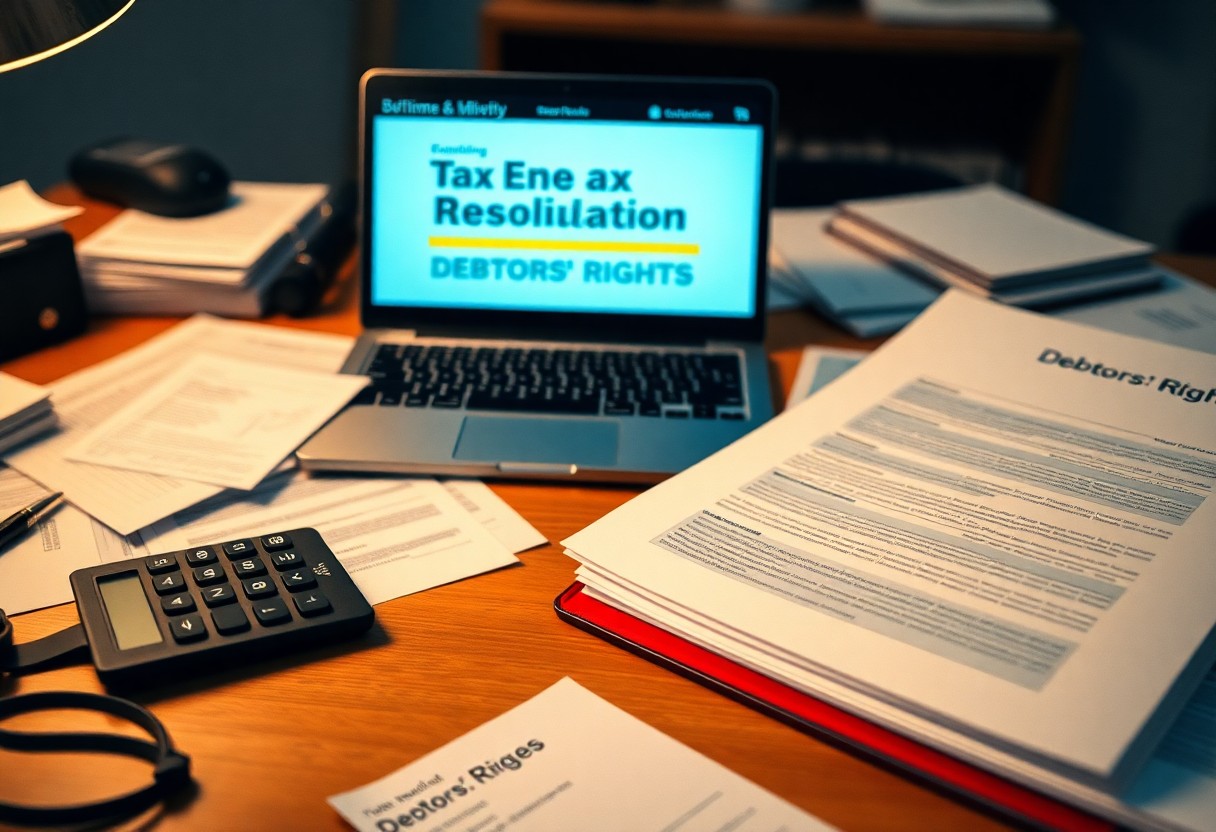You’re plunging into the dark waters of tax debt, and the IRS’s tax resolution framework is shrouded in mystery. As you navigate this complex system, you’ll encounter a labyrinth of rules and regulations. Your financial freedom is at stake, and the IRS holds the keys. You’re about to uncover the secrets and surprises that lie within the framework, and what you find may shock you. Get ready to expose the truth and take control of your tax debt destiny.”>

The IRS’s Tax Resolution Framework
Before submerging into the mysteries that lie within the IRS’s tax resolution framework for debtors, it’s necessary to understand the underlying structure that governs this complex system. You’re about to initiate on a journey through the twists and turns of tax debt resolution, where the lines between solvency and insolvency are constantly blurred. As you navigate this labyrinthine world, you’ll encounter a multitude of rules, regulations, and exceptions that will test your resolve and push your understanding of the system to its limits.
As you investigate deeper into the IRS’s tax resolution framework, you’ll begin to uncover the subtle nuances and contradictions that underpin this behemoth of a system. You’ll encounter debtors who have successfully navigated the trenches of tax debt, emerging victorious on the other side, while others have succumbed to the overwhelming weight of their obligations. The question is, what sets these two groups apart, and how can you avoid becoming a cautionary tale in the annals of tax debt history?
Overview of the Framework
With the IRS’s tax resolution framework, you’re faced with a multifaceted system that offers a variety of options for debtors to resolve their tax debt. You’ll encounter programs like Offer in Compromise, Installment Agreements, and Currently Not Collectible status, each with its own set of rules and requirements. As you explore these options, you’ll need to consider your financial situation, the type of tax debt you owe, and the potential consequences of each choice. The framework is designed to provide a way out for debtors, but it’s up to you to navigate its twists and turns to find the best solution for your specific circumstances.
With each step, you’ll need to carefully weigh the pros and cons of each option, considering the potential impact on your financial future. You’ll need to gather financial documents, calculate your income and expenses, and make a case for why you qualify for a particular program. The IRS will scrutinize your application, and you’ll need to be prepared to negotiate and advocate for yourself throughout the process. As you work your way through the framework, you’ll begin to see the outlines of a system that is both rigid and flexible, with room for interpretation and maneuvering.
Eligibility Criteria for Debtors
Along with the various programs and options available, the IRS’s tax resolution framework also comes with a set of eligibility criteria that debtors must meet in order to qualify. You’ll need to demonstrate financial hardship, provide detailed financial information, and meet specific requirements for each program. The criteria can be complex and nuanced, and you’ll need to carefully review your situation to determine which options are available to you. As you explore the eligibility criteria, you’ll begin to see the contours of a system that is designed to separate those who are truly in need from those who are simply trying to game the system.
Along the way, you’ll encounter a multitude of forms, deadlines, and requirements that must be met in order to qualify for tax debt relief. You’ll need to file specific forms, such as the Form 433-A or Form 656, and provide detailed financial information, including income statements and expense reports. The IRS will verify your information and assess your eligibility, and you’ll need to be prepared to respond to any questions or concerns they may have. As you navigate this process, you’ll begin to see the IRS’s tax resolution framework as a complex, ever-shifting landscape that requires careful navigation and attention to detail.
For instance, to qualify for an Offer in Compromise, you’ll need to demonstrate that you’re experiencing significant financial hardship, such as a serious medical condition or a recent job loss. You’ll need to provide detailed financial information, including your income, expenses, and assets, and demonstrate that you’re unable to pay your tax debt in full. The IRS will assess your situation and determine whether you qualify for an Offer in Compromise, which could potentially reduce your tax debt to a fraction of its original amount. As you consider this option, you’ll need to weigh the potential benefits against the potential risks and consequences, and make an informed decision about whether an Offer in Compromise is right for you.

Debt Relief Options
You trudge through the seemingly endless corridors of the IRS’s tax resolution framework, desperate for a glimmer of hope to alleviate your debt burden. As you explore deeper, you discover a labyrinthine system of debt relief options, each with its own set of complexities and pitfalls. The IRS, in its benevolence, has bestowed upon you several alternatives to mitigate your tax debt, but be warned: navigating these treacherous waters requires a steady hand and a keen mind. Your tax debt, much like a nagging specter, haunts your every waking moment, and it’s up to you to find a way to exorcise it.
Your quest for debt relief leads you down a twisted path of possibilities, each one promising salvation but potentially hiding unseen dangers. You must be cautious, for the IRS is not known for its magnanimity, and any misstep could prove disastrous. As you ponder your next move, you begin to realize that the IRS’s tax resolution framework is a Byzantine system, full of Byzantine complexities and contradictions. Your only hope lies in deciphering the code, in unraveling the mysteries that shroud the debt relief options, and in finding the one that best suits your particular predicament.
Currently Not Collectible Status
One of the most enigmatic debt relief options at your disposal is the Currently Not Collectible (CNC) status. This mystical designation implies that the IRS has temporarily abandoned its pursuit of your tax debt, not because you’ve been absolved of your obligations, but because your financial situation is deemed too precarious to warrant further collection efforts. Your economic hardship, in essence, becomes your greatest ally, as the IRS reluctantly acknowledges that attempting to collect from you would be a futile endeavor. As you navigate this precarious landscape, you must be aware that CNC status is not a permanent solution, and the IRS can reinitiate collection activities at any moment, leaving you once again at the mercy of the taxman.
One of the most significant advantages of CNC status is that it provides you with a temporary reprieve from the constant barrage of IRS collection notices and phone calls. Your financial situation, already precarious, is thus granted a measure of stability, allowing you to regroup and reassess your options. However, be aware that interest and penalties will continue to accrue on your tax debt, even as the IRS has deemed you currently not collectible. Your CNC status, in other words, is a double-edged sword, offering you a temporary respite while simultaneously exacerbating your long-term debt burden.
Offer in Compromise
Along the twisted path of debt relief options, you’ll encounter the Offer in Compromise (OIC), a tantalizing prospect that promises to settle your tax debt for a fraction of the original amount. This elusive Holy Grail of tax debt mitigation, however, is notoriously difficult to attain, as the IRS subjects your financial situation to a withering scrutiny, searching for any indication that you’re capable of paying a larger share of your debt. Your financial disclosures, in essence, become an open book, as the IRS seeks to verify that your offer is, indeed, the best you can muster. As you prepare your OIC, you must be prepared to surrender a thorough accounting of your financial affairs, including your income, expenses, and assets, all in the hopes of convincing the IRS that your offer is, indeed, a reasonable one.
Along with the OIC application, you’ll need to submit a detailed financial statement, replete with documentation to support your claims of economic hardship. Your task, in essence, is to persuade the IRS that your offer, though perhaps not the full amount of your tax debt, is nonetheless the most realistic settlement possible, given your current financial circumstances. As you navigate this labyrinthine process, you must be prepared for a potentially lengthy and contentious negotiation, as the IRS seeks to extract the maximum possible amount from your beleaguered finances.
Options for an Offer in Compromise are multifaceted, and you should carefully consider your financial situation before submitting an application. You may choose to pay your offer amount in a lump sum or opt for a periodic payment plan, whichever best suits your economic circumstances. As you weigh your options, keep in mind that the IRS is not obligated to accept your OIC, and you may need to negotiate or appeal the decision if it’s not in your favor. Your OIC application, in other words, is merely the opening salvo in what may prove to be a protracted and arduous process, one that demands your utmost attention and perseverance if you hope to emerge victorious.
The Role of the IRS in Debt Resolution
One of the most daunting tasks you’ll face when dealing with tax debt is navigating the IRS’s tax resolution framework. As you research into this complex system, you’ll begin to uncover the various roles the IRS plays in debt resolution. The IRS is not just a collector of taxes, but also a regulator, an enforcer, and a negotiator. Your understanding of these roles will be vital in finding a path to resolving your tax debt. The IRS’s primary goal is to collect the taxes you owe, but they also offer options for debtors to settle their debts through various programs and initiatives.
As you explore the IRS’s tax resolution framework, you’ll discover that the agency has a range of tools at its disposal to collect debts. You may be surprised to learn that the IRS can garnish your wages, seize your assets, and even impose penalties and interest on your outstanding tax bill. However, the IRS also offers alternatives to these draconian measures, such as payment plans and offers in compromise. Your ability to navigate these options will depend on your understanding of the IRS’s collections process and negotiation strategies.
Collections Process
On the surface, the IRS’s collections process appears to be a straightforward affair. You receive a notice stating the amount you owe, and you’re given a deadline to pay. However, as you dig deeper, you’ll find that the process is far more complex. You’ll need to understand the different types of notices the IRS sends, the various penalties and interest that can be imposed, and the options available to you for responding to these notices. Your goal should be to avoid the IRS’s more aggressive collection tactics, such as wage garnishment and asset seizure, by addressing your tax debt promptly and effectively.
On closer inspection, you’ll see that the IRS’s collections process is designed to encourage debtors to take proactive steps to address their tax debt. You’ll be given opportunities to respond to notices, to request extensions, and to propose payment plans. Your ability to negotiate with the IRS will depend on your understanding of the collections process and your willingness to engage with the agency. You should be prepared to provide detailed financial information, to explain your financial situation, and to propose a plan for paying your tax debt.
Negotiation Strategies
By examining the IRS’s negotiation strategies, you’ll gain a deeper understanding of the agency’s approach to debt resolution. You’ll learn that the IRS is willing to work with debtors who are proactive and cooperative, but that the agency can also be ruthless in its pursuit of tax debt. Your goal should be to find a middle ground, where you can negotiate a payment plan or settlement that meets your needs and satisfies the IRS’s requirements. You’ll need to be prepared to provide detailed financial information, to explain your financial situation, and to propose a plan for paying your tax debt.
By taking a closer look at the IRS’s negotiation strategies, you’ll discover that the agency is not always inflexible. You’ll find that the IRS offers a range of options for debtors, including payment plans, offers in compromise, and currently not collectible status. Your ability to navigate these options will depend on your understanding of the IRS’s negotiation strategies and your willingness to engage with the agency. You should be prepared to negotiate firmly but respectfully, to propose alternative solutions, and to seek professional help when needed.
Further investigation into negotiation strategies will reveal that the key to success lies in understanding the IRS’s motivations and limitations. You’ll learn that the IRS is driven by a desire to collect taxes, but that the agency also has a mandate to treat debtors fairly and with respect. Your goal should be to find a solution that meets your needs and satisfies the IRS’s requirements, by proposing a payment plan or settlement that is based on your financial situation and your ability to pay. You’ll need to be prepared to provide detailed financial information, to explain your financial situation, and to negotiate firmly but respectfully with the IRS.
Challenges Faced by Debtors
Now, as you investigate into the IRS’s tax resolution framework, you’ll encounter a labyrinth of complexities and obstacles that can leave even the most savvy individuals bewildered. You’ll find yourself navigating a system that seems designed to confuse and intimidate, with arcane rules and regulations that can make your head spin. The IRS’s tax code is a behemoth of bureaucracy, with clauses and sub-clauses that can trap even the most well-intentioned debtor in a cycle of debt and despair. You’ll need to be vigilant and prepared to tackle the challenges that lie ahead, lest you fall prey to the IRS’s formidable machinery.
As you struggle to make sense of the IRS’s tax resolution framework, you’ll begin to appreciate the sheer scale of the challenges that debtors face. You’ll encounter a system that seems stacked against you, with rules and regulations that can change on a whim. You’ll need to be agile and adaptable, able to think on your feet as you navigate the twists and turns of the tax code. But don’t worry, you’re not alone – countless others have faced similar challenges and emerged victorious. With the right mindset and a healthy dose of skepticism, you can overcome the obstacles and find your way to a more prosperous future.
Complexities of the Tax Code
Around every corner, you’ll find a new set of complexities and contradictions that can leave you questioning your sanity. You’ll encounter rules and regulations that seem to contradict each other, or clauses that are so vague they might as well be written in hieroglyphics. The tax code is a minefield of ambiguity, with hidden pitfalls and snares waiting to snag the unwary debtor. You’ll need to be cautious and meticulous, parsing every word and phrase to uncover the hidden meanings and implications. But don’t be discouraged – with persistence and determination, you can unravel the mysteries of the tax code and emerge victorious.
Around the edges of the tax code, you’ll find a plethora of gray areas and ambiguities that can leave you scratching your head. You’ll encounter rules that seem to apply in one situation, but not in another, or clauses that are so open-ended they might as well be meaningless. The tax code is a maze of contradictions, with different rules and regulations applying to different situations. You’ll need to be flexible and adaptable, able to think on your feet as you navigate the twists and turns of the tax code. But with the right guidance and support, you can navigate the complexities and find your way to a more prosperous future.
Limited Resources
Across the board, you’ll find that debtors are often hamstrung by limited resources and a lack of support. You’ll encounter a system that seems designed to favor the wealthy and well-connected, with loopholes and exemptions that can leave the average debtor feeling disfranchised and disenpowered. You’ll need to be proactive and resourceful, seeking out alternative sources of support and guidance to help you navigate the complexities of the tax code. But don’t be discouraged – with the right mindset and a healthy dose of skepticism, you can overcome the obstacles and find your way to a more prosperous future.
Across the landscape of tax debt, you’ll find a multitude of challenges and obstacles that can leave even the most determined debtor feeling overwhelmed. You’ll encounter a system that seems designed to grind you down, with repeated setbacks and frustrations that can wear you down. But don’t give up – with persistence and determination, you can overcome the obstacles and find your way to a more prosperous future. You’ll need to be resilient and resourceful, able to bounce back from setbacks and keep moving forward, even in the face of adversity.
With limited resources at your disposal, you’ll need to be strategic and targeted in your approach, focusing on the most critical areas of the tax code and seeking out expert guidance and support where needed. You’ll need to be meticulous and thorough, pouring over every detail and clause to ensure that you’re taking advantage of every available exemption and loophole. But with the right mindset and a healthy dose of skepticism, you can navigate the complexities of the tax code and emerge victorious, your finances intact and your future secure. You’ll be able to look back on your journey with a sense of pride and accomplishment, knowing that you’ve overcome the obstacles and achieved your goals.
Potential Reforms and Improvements
Despite the complexity of the IRS’s tax resolution framework, there are potential reforms and improvements that could make the process more efficient and fair for debtors. You may be surprised to learn that the current system is often criticized for being overly bureaucratic and slow, leaving many individuals and businesses stuck in a cycle of debt and uncertainty. As you navigate the treacherous waters of tax debt, you’ll likely encounter a multitude of forms, deadlines, and requirements that can be daunting to say the least. But what if the process could be streamlined, made more transparent, and more debtor-friendly?
As you examine deeper into the possibilities, you’ll find that there are many potential reforms that could alleviate the burden on debtors. The IRS could implement more flexible payment plans, offer additional relief programs, and provide clearer guidance on the tax resolution process. You’ll also discover that some advocates are pushing for a more holistic approach to tax debt, one that takes into account the unique circumstances and challenges faced by individual debtors. By exploring these potential reforms, you can gain a better understanding of how the IRS’s tax resolution framework could be improved to better serve your needs.
Streamlining the Resolution Process
About the only thing that’s clear when it comes to the IRS’s tax resolution framework is that it’s in dire need of streamlining. You’ll find that the current process is often marked by unnecessary complexity, with multiple steps and requirements that can slow down the resolution process. As you work to resolve your tax debt, you’ll likely encounter a multitude of forms, deadlines, and requirements that can be overwhelming. But what if the process could be simplified, with clearer guidance and more efficient procedures?
About the time you think you’ve got a handle on the process, you’ll encounter another hurdle, another obstacle that must be overcome. But by streamlining the resolution process, the IRS could make it easier for debtors to navigate the system and find a resolution that works for them. You’ll find that a more efficient process could also reduce the stress and anxiety associated with tax debt, allowing you to focus on getting back on your feet financially.
Increasing Transparency
Along with streamlining the resolution process, increasing transparency is another key area where the IRS could improve its tax resolution framework. Along the way, you’ll discover that the current system often lacks clarity, with debtors left in the dark about their options and the potential outcomes of different scenarios. As you work to resolve your tax debt, you’ll likely encounter a multitude of confusing terms, complex procedures, and unclear guidance that can make it difficult to make informed decisions.
Along the lines of greater transparency, you’ll find that the IRS could provide more detailed information about the tax resolution process, including the potential benefits and drawbacks of different options. Along with clearer guidance, the IRS could also provide more regular updates and communication, keeping debtors informed about the status of their cases and any changes to the process.
Even as you struggle to make sense of the IRS’s tax resolution framework, you’ll find that increasing transparency could have a profound impact on your experience as a debtor. Even with the complexities and challenges of the current system, you’ll discover that a more transparent process could help you make more informed decisions, avoid costly mistakes, and ultimately achieve a more favorable outcome. By shedding more light on the tax resolution process, the IRS could help you navigate the system with greater confidence and clarity, and ultimately emerge from the experience with a cleaner bill of health and a fresher start.

Implications for Taxpayers and the Economy
All taxpayers who find themselves entangled in the complex web of tax debt should be aware of the implications that the IRS’s tax resolution framework has on their financial stability and the broader economy. You are not alone in this struggle, as many individuals and businesses face similar challenges when dealing with tax debt. The framework is designed to provide options for resolving tax debt, but it can be daunting to navigate, leaving you to wonder what the best course of action is. As you probe into the world of tax resolution, you begin to uncover the intricacies of the system and the potential consequences of your decisions.
Your understanding of the tax resolution framework is vital in making informed decisions about your financial future. You need to consider the potential impact of your choices on your credit score, financial stability, and overall well-being. The IRS’s tax resolution framework is not just a set of rules and regulations; it is a complex system that can have far-reaching consequences for your financial stability and the economy as a whole. As you navigate this system, you must be aware of the potential pitfalls and opportunities that exist, and make informed decisions that align with your financial goals.
Impact on Financial Stability
Betwixt the lines of the tax code, you will find that the IRS’s tax resolution framework can have a significant impact on your financial stability. You may find yourself facing a daunting array of options, from installment agreements to offers in compromise, each with its own set of benefits and drawbacks. You must carefully consider your financial situation and goals when choosing a tax resolution option, as the wrong choice can lead to further financial instability. As you weigh your options, you should consider seeking the advice of a tax professional to ensure that you make the best decision for your unique situation.
Between the complexity of the tax code and the potential consequences of your decisions, you may feel overwhelmed by the process of resolving your tax debt. You are not alone in this feeling, as many taxpayers struggle to navigate the system and make informed decisions about their financial future. However, with the right guidance and support, you can make your way through the tax resolution framework and emerge with a more stable financial foundation. You should take the time to educate yourself on the options available to you and seek the advice of a tax professional if needed.
Broader Economic Consequences
One of the most significant aspects of the IRS’s tax resolution framework is its impact on the broader economy. You may not think that your individual tax debt has a significant impact on the economy, but collectively, the tax debts of millions of taxpayers can have far-reaching consequences. You should consider the potential economic consequences of the tax resolution framework, including the impact on government revenue, economic growth, and job creation. As you navigate the tax resolution process, you are not just making decisions about your own financial future; you are also contributing to the overall health of the economy.
One of the key considerations in understanding the broader economic consequences of the tax resolution framework is the impact on government revenue. You should recognize that the taxes you pay are used to fund public goods and services, and that tax debt can reduce the amount of revenue available for these purposes. As you make decisions about your tax debt, you should consider the potential impact on government revenue and the broader economy. You can take an active role in contributing to the overall health of the economy by making informed decisions about your tax debt and seeking the advice of a tax professional if needed.
A deeper examination of the broader economic consequences of the tax resolution framework reveals a complex web of relationships between taxation, economic growth, and job creation. As you consider the potential impact of the tax resolution framework on the economy, you should think about the ways in which taxation can influence economic activity, including the impact on consumer spending, investment, and job creation. You can gain a deeper understanding of the tax resolution framework and its implications for the economy by exploring the ways in which taxation can shape economic outcomes, and making informed decisions about your tax debt that align with your financial goals and contribute to the overall health of the economy. You should take the time to educate yourself on the tax resolution framework and its broader economic implications, and seek the advice of a tax professional if needed to ensure that you make the best decisions for your unique situation.
To wrap up
With these considerations, you’re now staring into the abyss of the IRS’s tax resolution framework, wondering what other mysteries lie hidden beneath the surface. As you navigate the labyrinthine corridors of tax debt, you begin to realize that the line between salvation and suffocation is perilously thin. The IRS’s framework, with its promises of relief and reprieve, can be a siren’s song, luring you into a false sense of security. But you’re not one to be swayed by empty promises; you’re a seeker of truth, a hunter of hidden meanings and unseen consequences. And so, you press on, driven by a nagging sense that there’s more to the story than meets the eye.
As you investigate deeper into the mysteries of the IRS’s tax resolution framework, you start to uncover the hidden patterns and codes that govern the system. You begin to see that the framework is not just a set of rules and regulations, but a complex web of incentives and penalties, designed to keep you in a state of precarious balance. You realize that your debt is not just a financial burden, but a moral and psychological one, weighing heavily on your conscience and eroding your sense of self-worth. And yet, with this knowledge, you also sense a glimmer of hope – a hope that you can outsmart the system, that you can find a way to escape the cycle of debt and emerge victorious. The question is, will you take the leap of faith, or will you remain trapped in the IRS’s web of intrigue? The choice is yours, and yours alone.















